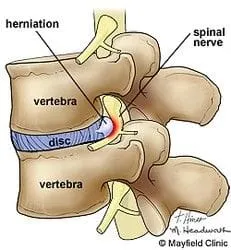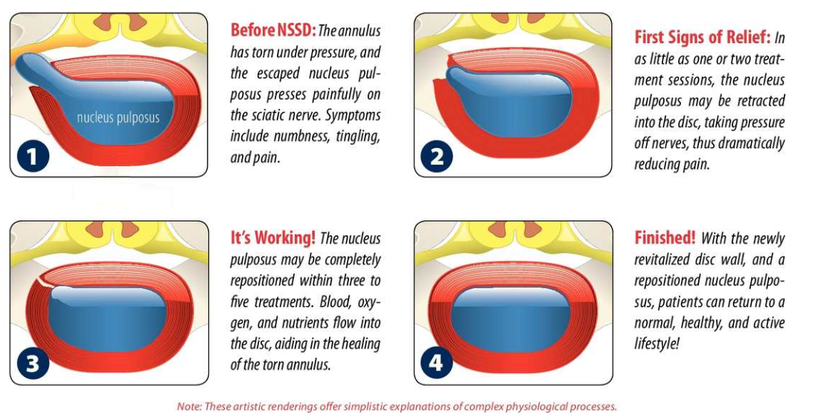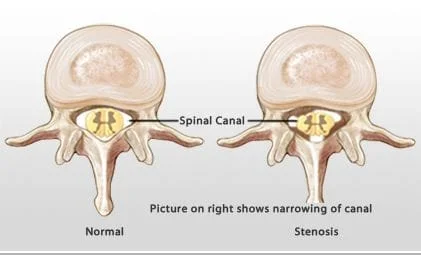"ALL ROADS LEAD TO DISC"
Today, you don’t have to live with that pain/ neuropathy anymore. Spinal Decompression was developed to effectively treat lower back pain and sciatica resulting from herniated or bulging discs. Spinal Decompression not only significantly reduces back pain in many patients, but also enables the majority of patients to get their life back.
Does Spinal Decompression really work?
Spinal Decompression has been proven effective in relieving the pain associated with bulging and herniated discs, sciatica, radiating nerve pain, neuropathies, weak legs, foot drop, facet syndrome and failed back surgery. Since its release, clinical studies have revealed an amazing success rate in treating lumbar disc related problems with Spinal Decompression therapy.
How does it work?
Spinal Decompression uses technology to apply a distraction energy to relieve nerve compression often associated with low back pain.
Contact our office today to schedule a free MRI review ($100 value) with Dr. Cooper to determine if you are a candidate for care with Spinal Decompression. Dr. Cooper will sit down and explain his recommended plan of action for you. After answering any questions you may have about the recommended plan, you may begin your care with Spinal Decompression.
Dr. Cooper has been helping people get well from chronic back pain for well over 15 years, utilizing Non-Surgical Spinal Decompression. It's life changing.
Advanced degenerative disc disease treatment without surgery. Disc Centers of Plantation have specially designed treatment for spinal stenosis, herniated discs, sciatica, failed back syndrome and other degenerative changes in the spine.
Contact us today to see if you're a candidate.

Spinal decompression is FDA cleared and the treatment of the future.
This gentle, True Non Surgical Spinal Decompression therapy can provide long term low back pain relief.
When selecting a provider that offers Non Surgical Spinal Decompression, one should be aware, that not all providers use true Spinal Decompression tables. Many providers use that verbiage, but are actually using a traction table. Most providers have little to no advanced training with Spinal Decompression Therapy.
I use a true Decompression Table and I have continual educational training in the treatment of Spinal Decompression Therapy. No other provider in Broward/ Palm Beach can make that claim. You can feel secure that you are in the right place and my goal is to get you well.
Anatomy of the spine
The intervertebral discs are located between each vertebrae in the spinal column. Of the vertebrae, there are 7 cervical (neck), 12 thoracic (mid-back) and 5 lumbar (low back) discs. The discs make up approximately 1/3 of the spinal column. They have three main functions: (1) "Absorb shock" from everyday wear and tear. (2) Allow movement of our spinal column. (3) Separate the vertebrae. The intervertebral disc is actually a type of cartilaginous joint. Discs consist of an outer layer, annulus fibrosis, and an inner nucleus pulposus, which is a soft, jelly-like, substance. The disc is made up of proteins called collagen and proteoglycans that attract water. Normally, discs compress when pressure is put on them and decompress when the pressure is relieved. These discs do not have a blood supply; therefore, they exchange nutrients by a process called "imbibition". Imagine a sponge filled with water; when that sponge is compressed, the water is forced out of the sponge. When the compressive force is removed, the water is "sucked" back into the sponge. This is precisely how discs stay healthy and functional. Diseased discs can lead to degenerative disc disease that can then lead to: arthritis, herniated discs, bulging discs, facet syndromes, sciatica and spinal stenosis. A herniation describes an abnormal condition of an intervertebral disc. Some refer to this condition as a "slipped", "ruptured", or "blown" disc. Most of the time it is not known what caused the disc to herniate, but it is thought to occur from repetitive stress due to occupation, poor spinal posture, and/or natural processes of aging and/or trauma. A herniation begins when the inner nucleus pulposus bulges through the annulus fibrosis, causing a bulging or protruding disc. This bulge may push on a spinal nerve. This interferes with the natural blood supply to the nerve roots and sets up a condition known as intraneural edema. Basically, the nerve root microcirculation is compressed and can progress to the point where the nucleus begins to leak out of the disc. At this point the body begins to fight back by launching an autoimmune response to the disc material (nucleus pulposus). The reaction of this defense mechanism causes severe inflammation and progressive deterioration of the nerve root. If the herniation is located in the cervical spine (neck), the symptoms can range from neck pain, with or without arm pain, to numbness and tingling. Muscle weakness can be common as well. If the herniated disc is located in the lumbar spine (low back), the symptoms can range from low back pain, with or without leg pain, to numbness and tingling. Muscle weakness is also common. This type of pain and/or numbness in the legs or arms is referred to as a "radiculopathy". This happens because the nerves that exit your spinal cord innervate ("attach to") the skin in your arms and legs. They are responsible for sensation and for movement of the muscles in your arms and legs. They are also responsible for the reflexive movements as well. This is the reason some individuals with these conditions experience extremity (leg/arm) pain / numbness / tingling and/or weakness when they have a herniated or bulging disc. Be aware that, some individuals with herniated discs may report arm or leg pain only, with minimal neck or low back pain.
NON-SURGICAL SPINAL DECOMPRESSION
Non-Surgical Spinal Decompression treats the root cause of the diseased or pathological disc based on the anatomical and physiological principles of Non-Surgical Spinal Decompression. Non-Surgical Spinal Decompression relieves pressure from the disc, which, in turn, relieves pressure from the nerve. "Nerve root flossing" Research has shown that Non-Surgical Spinal Decompression creates a negative pressure within the disc causing a "vacuum effect". This vacuum effect can "suck" the disc material back inside, thus relieving the pressure from the nerve. According to the FDA 510k papers, the definition of decompression is "unloading due to distraction and positioning", and additionally, "unweighting due to distraction and positioning". This is important because the "unloading" of the injured area creates positive changes in the microcirculation of the disc and nerve roots. Therefore, Non-Surgical Spinal Decompression for herniated discs is based on the following principles.
|
MECHANISM
When pressure builds up inside the disc, it causes bulging of the jelly-like disc material. With increasing or prolonged pressure, it often leads to a disc rupture or herniation which spills out the disc material.
The bulging or spilled disc material is what puts pressure on the nerves and other structures that cause pain. This pain can travel into the buttocks and down the legs or into the toes. It can cause numbness and also lead to dysfunction.
Decompression relieves pain by creating a vacuum type suction which reverses the high pressure inside the disc (high intra-discal pressure) and draws the bulging or herniated material back into the disc. This procedure is called non-surgical spinal decompression and has a high success rate in patients with herniated discs. This is truly a medical breakthrough.
The gentle distractive forces of the True Non Surgical Spinal Decompression therapy create a decompression of the spine with unloading due to distraction and proper positioning, to improve blood flow and nutrient exchange to the injured area.
TREATMENT PLAN It is essential for both the staff and the patient to work toward the same objective when utilizing Non-Surgical Spinal Decompression Therapy. Spinal Decompression Therapy has a goal; and it is important that each patient understand both the objective and method that will be used to attain this goal. This will prevent any confusion and give clear expectations for the patient. Patients are treated fully clothed and are fitted with a pelvic harness that fits around their pelvis as well as a thoracic harness as they lie face up on a computer controlled table. The doctor operates the table from a computerized console, where a customized treatment protocol is entered into the computer. Each treatment takes about 30 minutes. The average treatment protocol is approximately 20 to 25 treatments within a six to eight week period of time, depending on the individual's case. A complete program targeting the function of the stabilization muscles is a vital part of True Non Surgical Spinal Decompression Therapy. Adjustments, Core strengthening and adjunctive therapies such as ice, heat, interferential stimulation, Myofascial/Neuromuscular work and ultrasound can assist in rehabilitation of these structures. Our goal is to not only help heal the disc, but to also enhance muscular control and support of the back. Drinking at least 1/2 ounce of water per pound per day will enhance the re-hydration process within the discs. Your physician will also recommend some nutritional supplements that will aid in the healing process. Although there is no procedure that is 100% successful, non-surgical spinal decompression therapy has a high success rate with full compliance on the part of the patient. Your doctor will recommend that you refrain from certain activities and that you engage in a certain rehabilitation program either during or after your therapy. If you adhere to your prescribed therapy, you will enhance your chances of success. |
Regular home exercise and periodic visits to our office will help in maintaining your spinal health and reduce the probability of reoccurrence. Most patients find long-term relief or effective management of their pain when they complete the entire program of treatments utilizing the True Non Surgical Spinal Decompression Therapy.


